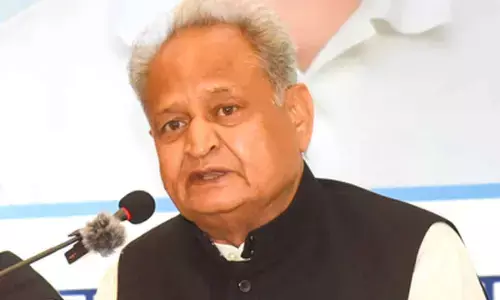Unconquered fortress of Kumbhalgarh: The great wall of Bharat

Kumbhalgarh Fort, located in the rugged hills of the Aravalli Range in Rajasthan, stands as one of Bharat’s most remarkable and lesser-known architectural marvels.
Kumbhalgarh Fort, located in the rugged hills of the Aravalli Range in Rajasthan, stands as one of Bharat’s most remarkable and lesser-known architectural marvels. Built in the 15th century by Maharana Kumbha, the fort has gained global recognition as a UNESCO World Heritage Site, thanks to its impressive architecture, extensive fortifications, and rich cultural heritage. Though lesser celebrated than some of Bharat’s other historical landmarks, Kumbhalgarh Fort has immense historical, military, and cultural significance that stands as a testament to the valor and ingenuity of the Rajput rulers.
Historical Background
Kumbhalgarh Fort was commissioned by Maharana Kumbha, a ruler of the Sisodia Rajput clan of Mewar, in 1443 CE. The primary purpose of the fort was to provide a defensive stronghold for the Mewar kingdom, a region that frequently faced invasions. Located about 80 km northwest of Udaipur, the fort’s strategic position atop the Aravalli hills made it nearly impregnable. Over the centuries, it served as a safe haven for the rulers of Mewar, including the legendary Maharana Pratap, who was born within its walls.
The fort’s importance in Rajput history is inextricably tied to the constant threat of invasions, particularly from the Mughals. It served as a sanctuary for rulers during times of crisis and played a pivotal role in the Rajputs’ defensive strategy. Despite numerous attempts, Kumbhalgarh was captured only once, and even then, it was through deceit rather than brute force. This legacy of resilience is a major part of the fort’s enduring appeal.
The Great Wall of Kumbhalgarh
Kumbhalgarh is famous for its massive defensive walls, which stretch over 36 kilometers, making it the second-longest continuous wall in the world, surpassed only by the Great Wall of China. Built primarily using stone masonry, the walls are up to 15 feet thick in certain areas, designed to withstand the test of time and human assault.
The wall was not merely a defensive structure but also a psychological barrier for invaders. Its imposing size and robust construction deterred enemies, and the bastions and watchtowers along the wall allowed for constant surveillance of the surrounding areas. These fortifications ensured that Kumbhalgarh remained a fortress of immense military value throughout its history.
Seven massive gates guard the fort, with the Ram Pol being the main entrance. Each of these gates was designed to be nearly impenetrable, adding to the fort’s overall strength. The gates were intricately adorned with carvings, further reflecting the Rajput’s artistic sensibilities alongside their military prowess.
Architectural Grandeur
Beyond its defensive walls, Kumbhalgarh Fort houses a wealth of palaces, temples, and other structures, showcasing the architectural brilliance of the Rajputs. Among the most notable is the Badal Mahal (Palace of Clouds), a two-storied structure perched at the highest point of the fort. The palace is divided into two sections: one for men and the other for women. The rooms in Badal Mahal are decorated with beautiful murals and frescoes, illustrating the artistic inclinations of the time. The palace also provides breathtaking views of the surrounding landscape, offering a vantage point that further added to the fort’s defensive capabilities.
Kumbhalgarh is also home to more than 300 temples. The Neelkanth Mahadev Temple, dedicated to Lord Shiva, is among the most prominent. This temple features a massive lingam, a symbol of Lord Shiva, and serves as an important religious site within the fort. The numerous temples scattered throughout the fort reflect the Rajputs’ deep connection to spirituality, which was seamlessly integrated into their military and royal life.
The fort also contains several water reservoirs, stepwells, and tanks that were vital for sustaining life during sieges. Among them, the Lakhola Tank, built by Rana Lakha, is the largest water reservoir within the fort and played a crucial role in ensuring a steady water supply during times of isolation.
Military Ingenuity
Kumbhalgarh Fort’s design represents a masterful blend of military strategy and architectural beauty. Its high altitude, formidable walls, bastions, and watchtowers were all meticulously planned to provide maximum defense against enemy invasions. The fort’s steep terrain made it extremely difficult for attackers to mount successful assaults, while its well-positioned towers offered clear views of any approaching threats.
Kumbhalgarh’s defense mechanisms extended beyond just its walls and terrain. The fort’s complex of gates, many of which were layered and reinforced, provided multiple lines of defense. The architectural layout of the fort allowed for the easy mobilization of troops and resources, ensuring that defenders could mount effective counter-attacks during sieges.
Cultural and Historical Significance
Kumbhalgarh is not only a military stronghold but also a symbol of Rajput culture, embodying the spirit of resistance and resilience that defined the kingdom of Mewar. It served as a critical center of Rajput power and provided refuge for rulers, including Maharana Pratap, one of the most revered figures in Bharatn history. Maharana Pratap’s defiance against the Mughal Emperor Akbar is legendary, and Kumbhalgarh’s association with this proud legacy enhances its historical importance.
Maharana Kumbha, after whom the fort is named, was a great patron of the arts and architecture. In addition to Kumbhalgarh, he commissioned the construction of numerous other forts, making Mewar one of the most fortified regions in Bharat. His contributions to Bharatn architecture are significant, and Kumbhalgarh Fort stands as one of his most impressive achievements.
Modern-Day Legacy and Preservation
In modern times, Kumbhalgarh Fort has become a popular tourist destination, drawing visitors from around the world who come to marvel at its architectural brilliance and historical significance. The fort is one of the most well-preserved in Bharat, and its recognition as a UNESCO World Heritage Site underscores its global cultural importance.
The annual Kumbhalgarh Festival, organized by the Department of Tourism, Government of Rajasthan, further highlights the fort’s role in preserving and celebrating the region’s cultural heritage. This festival features traditional music, dance, and crafts, offering visitors a glimpse into the rich traditions of Rajasthan within the fort’s majestic setting.
Efforts to preserve Kumbhalgarh’s structural integrity have been ongoing, ensuring that future generations can continue to experience this symbol of Bharat’s architectural and military legacy. The fort stands not only as a testament to the ingenuity of the Rajput rulers but also as a reminder of the rich history and culture that shaped the region.
Kumbhalgarh Fort is a monumental symbol of Rajasthan’s rich heritage, blending history, culture, and military strategy in one awe-inspiring structure. From its massive walls to its intricate palaces and temples, the fort provides a window into the lives of the Rajput rulers who defended their kingdom with unparalleled valor. Kumbhalgarh’s status as a UNESCO World Heritage Site ensures that its legacy will be preserved for generations to come, continuing to inspire awe and admiration among all who visit.
















